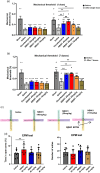Inhibition of calcium-stimulated adenylyl cyclase subtype 1 (AC1) for the treatment of pain and anxiety symptoms in Parkinson's disease mice model
- PMID: 38912637
- PMCID: PMC11282525
- DOI: 10.1177/17448069241266683
Inhibition of calcium-stimulated adenylyl cyclase subtype 1 (AC1) for the treatment of pain and anxiety symptoms in Parkinson's disease mice model
Abstract
Pain and anxiety are two common and undertreated non-motor symptoms in Parkinson's disease (PD), which affect the life quality of PD patients, and the underlying mechanisms remain unclear. As an important subtype of adenylyl cyclases (ACs), adenylyl cyclase subtype 1 (AC1) is critical for the induction of cortical long-term potentiation (LTP) and injury induced synaptic potentiation in the cortical areas including anterior cingulate cortex (ACC) and insular cortex (IC). Genetic deletion of AC1 or pharmacological inhibition of AC1 improved chronic pain and anxiety in different animal models. In this study, we proved the motor deficit, pain and anxiety symptoms of PD in 1-methyl-4-phenyl-1,2,3,6-tetrahydropyridine (MPTP)-treated mice model. As a lead candidate AC1 inhibitor, oral administration (1 dose and seven doses) of NB001 (20 and 40 mg/kg) showed significant analgesic effect in MPTP-treated mice, and the anxiety behavior was also reduced (40 mg/kg). By using genetic knockout mice, we found that AC1 knockout mice showed reduced pain and anxiety symptoms after MPTP administration, but not AC8 knockout mice. In summary, genetic deletion of AC1 or pharmacological inhibition of AC1 improved pain and anxiety symptoms in PD model mice, but didn't affect motor function. These results suggest that NB001 is a potential drug for the treatment of pain and anxiety symptoms in PD patients by inhibiting AC1 target.
Keywords: Anxiety; NB001; Parkinson’s disease; adenylyl cyclase subtype 1; pain.
Conflict of interest statement
Declaration of conflicting interestsThe author(s) declared no potential conflicts of interest with respect to the research, authorship, and/or publication of this article.
Figures





References
-
- Le HC, Daniel M, Tim A. Progression in Parkinson’s disease: a potpourri of plots and probabilities. Brain 2021; 144(3): 708–711. - PubMed
-
- Weerkamp NJ, Nijhof A, Tissingh G. Non-motor symptoms of Parkinson’s disease. Ned Tijdschr Geneeskd 2012; 156: A3926. - PubMed
-
- Armstrong MJ, Okun MS. Diagnosis and treatment of Parkinson disease: a review. JAMA, J Am Med Assoc 2020; 323: 548–560. - PubMed
MeSH terms
Substances
LinkOut - more resources
Full Text Sources
Medical
Research Materials

